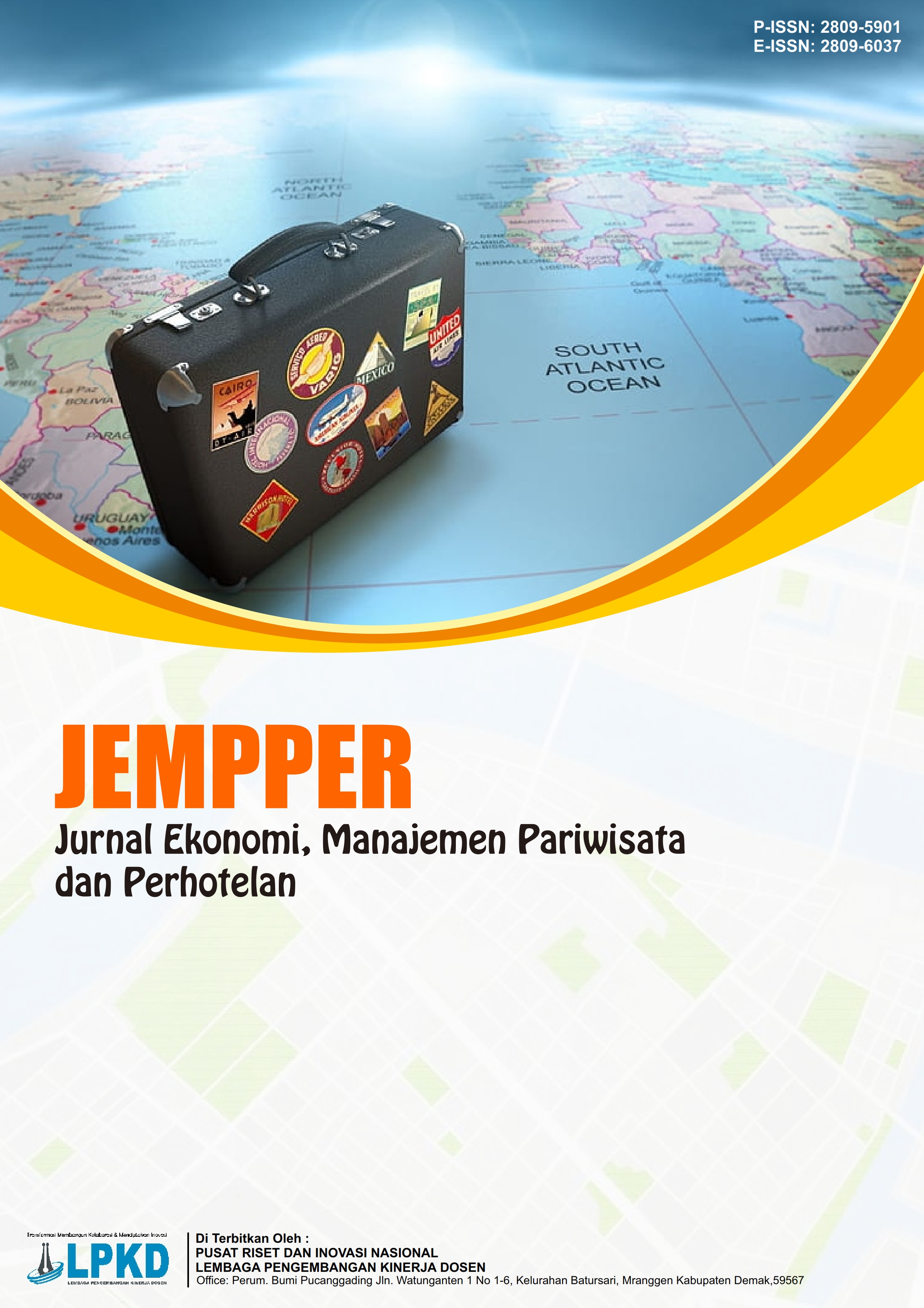Pengaruh Citra Destinasi terhadap Minat Berkunjung Kembali dengan Pengalaman Pengunjung sebagai Variabel Mediasi
Studi pada Wisata Kebun Raya Purwodadi Kabupaten Pasuruan
DOI:
https://doi.org/10.55606/jempper.v4i3.5072Keywords:
Destination Image, Interest in Visiting, Interest Revisiting, PLS-SEM, Visitor ExperienceAbstract
This study aims to explore the influence of destination image on visitors' intention to revisit Purwodadi Botanical Gardens in Pasuruan Regency, and examine the role of visitor experience as a mediating variable. This study uses a quantitative approach with an explanatory method. Data were collected through an online questionnaire distributed to 100 respondents who were visitors to Purwodadi Botanical Gardens. Data analysis was conducted using the Partial Least Square - Structural Equation Modeling (PLS-SEM) technique with the assistance of SmartPLS software. The results showed that destination image did not have a significant direct influence on the intention to revisit. However, destination image was proven to have a significant influence on visitor experience. Furthermore, visitor experience had a significant positive influence on the intention to revisit. These findings indicate that visitor experience significantly mediates the relationship between destination image and revisit intention. These findings strengthen the relevance of the Stimulus-Organism-Response (SOR) Model and the Theory of Planned Behavior, which states that initial perceptions of a destination (stimulus) do not automatically influence behavior (response), but need to be internalized through meaningful experiences (organism). Therefore, managing positive and memorable experiences is key to building visitor loyalty. The practical implication of this research is the importance for managers of Purwodadi Botanical Gardens and other educational tourism destinations to prioritize developing the visitor experience. Strategies such as improving services, providing interactive educational facilities, and creating a comfortable and enjoyable atmosphere can contribute to creating memorable experiences that encourage visitors to return in the future.
References
Ajzen, I. (1991). The theory of planned behaviour. Organizational Behavior and Human Decision Processes, 50(2), 179-211. https://doi.org/10.1016/0749-5978(91)90020-T
CNBC Indonesia. (2021, Desember 22). Sandi Uno: Bali penyumbang devisa terbesar di pariwisata RI. https://www.cnbcindonesia.com/news/20211222193439-4-301297/sandi-uno-bali-penyumbang-devisa-terbesar-di-pariwisata-ri
Echtner, C. M., & Ritchie, J. R. B. (1991). The meaning and measurement of destination image. In A. M. C. Crotts & J. R. B. Ritchie (Eds.), Tourism marketing and management handbook (pp. 41-52). Prentice Hall.
Ghozali, I. (2014). Structural equation modeling: Metode alternatif dengan partial least square (PLS). Badan Penerbit Universitas Diponegoro.
Ghozali, I., & Latan, H. (2012). Partial least square: Konsep, teknik dan aplikasi SmartPLS 2.0 M3. Badan Penerbit Universitas Diponegoro.
Ghozali, I., & Latan, H. (2015). Partial least squares: Konsep, teknik dan aplikasi SmartPLS 2.0 M3 (Edisi 2). Badan Penerbit Universitas Diponegoro.
Kim, J. H. (2017). The impact of memorable tourism experiences on loyalty behaviors: The mediating effects of destination image and satisfaction. Journal of Travel Research, 57(7), 856-870. https://doi.org/10.1177/0047287517721369
Mackiewicz, J. (2018). A mixed-method approach. In Writing center talk over time. Routledge. https://doi.org/10.4324/9780429469237-3
Mehrabian, A., & Russell, J. A. (1974). The basic emotional impact of environments. Perceptual and Motor Skills, 38(1), 283-301. https://doi.org/10.2466/pms.1974.38.1.283
Neuman, W. L. (2015). Social research methods: Qualitative and quantitative approaches (7th ed.). Pearson.
Oliver, R. L. (1980). A cognitive model of the antecedents and consequences of satisfaction decisions. Journal of Marketing Research, 17(November), 460-469. https://doi.org/10.2307/3150499
Roscoe, J. T. (1975). Fundamental research statistics for the behavioral sciences (2nd ed.). Holt, Rinehart and Winston.
Schwaighofer, B. (2014). Tourist destination images and local culture. https://doi.org/10.1007/978-3-658-04521-0
Zeithaml, V. A., Berry, L. L., & Parasuraman, A. (1996). The behavioral consequences of service quality. Journal of Marketing, 60(2), 31-46. https://doi.org/10.1177/002224299606000203
Zhang, H., Wu, Y., & Buhalis, D. (2018). A model of perceived image, memorable tourism experiences and revisit intention. Journal of Destination Marketing & Management, 8, 326-336. https://doi.org/10.1016/j.jdmm.2017.06.004







